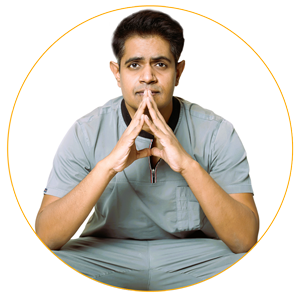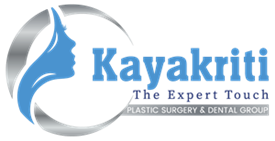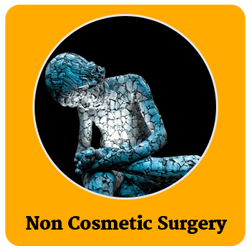Hemifacial Atrophy
Hemifacial atrophy is a condition in which the skin & soft tissues of one-half of the face start to shrink progressively over time.

Best treatment for Hemifacial Atrophy in India
What is Hemifacial atrophy?
Hemifacial atrophy is a condition in which the skin & soft tissues of one-half of the face start to shrink progressively over time. It gives a sunken appearance to the face. Rarely are both sides of the face affected. Sometimes the limbs may also be affected on the same side as that of the face. This disease is slowly progressive.
This is a rare disorder which is also called Romberg Syndrome.
When is Romberg Syndrome detected?
Additional abnormalities of the eye, brain & teeth may also develop in these patients. Romberg syndrome usually becomes apparent during the first decade of life or early during the second decade but can occur in adulthood also. Most individuals with Romberg syndrome experience symptoms before the age of 20 years.
This condition may worsen for many years & then stabilize. The severity of the disease varies among affected people.
This condition may also be called as
- Progressive Facial Hemiatrophy.
- Romberg Syndrome.
There is no disability other than cosmetic effects in mild cases. Only in some cases, the atrophy stops before the entire face is affected Recurrence is rare.
Occasionally, it may be accelerated, secondary to stress, surgery, pregnancy, or shortly after childbirth.
What are the causes of Hemifacial atrophy
The cause of this condition is unknown. It appears randomly in individuals. Abnormal development or inflammation in the nervous system, viral infections, trauma, abnormality in the formation of blood vessels, and autoimmunity may all be blamed for the causation of this disease.
What are the Symptoms of Hemifacial atrophy?
- Progressive tissue wasting in one half of the face.
- The sharp line of demarcation resembles a linear scar between normal & abnormal skin- The coup de Sabre Sign.
- Shrinkage & atrophy of tissues beneath the skin in the fat layer & the underlying muscles & bones.
- The skeleton-like appearance of the face.
- Dark pigmentation of the skin
- Atrophy of half of the upper lip & tongue.
- Deviation of jaws while opening the mouth.
- Delayed eruption of teeth, Malocclusion, and Posterior open bite.
- Migraine headaches are accompanied by visual symptoms, light sensitivity, nausea & vomiting.
- Epilepsy attacks.
- Spasms of jaws.
- Drooping of the upper eyelid.
- Difficulty closing the eyes.
How is Hemifacial atrophy diagnosed?
- Based on the identification of characteristic features, the diagnosis is quite clear.
- Presence of a White line or furrow on one side & a classical 'Coup de Sabre sign'.
- Facial atrophy on the affected side.
- MRI is done in case of fits/epilepsy or any other neurological problem
- Examination of the eye should be done to rule out any abnormality.
- Biopsy of the skin can be done from the area of the white line if present.
What is the treatment of Hemifacial atrophy?
There is no medical treatment or medicines available to stop the progression or reverse the disease. Surgery is the only option for this condition.
Surgical correction is attempted to balance out the facial features on both sides of the face and is usually done when the disease is completely stabilized with no more shrinkage on the face.
Three types of surgical procedures can be done in hemifacial atrophy
- Soft tissue correction with fat grafting.
- Correction by a microvascular flap surgery
- Bony corrections with osteotomy corrections
The type of surgical procedure chosen depends on the severity of the deformity of the face in hemifacial atrophy.
For mild and smaller asymmetry of the face
Fat grafting is the best modality for treating mild and smaller asymmetries of the face in hemifacial atrophy.
Fat grafting can be done under local anesthesia or general anesthesia depending upon your choice and comfort level. In the first step, liposuction is done to harvest healthy fat from another area of the body (usually the belly, thighs, or buttocks). This fat is then purified, processed, and prepared for grafting. A fine needle and cannula are used to inject the healthy fat into those areas of the face that have signs of deformity. To account for the body's natural reabsorption of the injected fat, overcorrection is done (more fat than required is injected). The face is gently massaged to ensure the fat is evenly distributed, addressing your initial goals for the procedure.
For severe deformities or asymmetries
Fat grafting done in stages gives good and acceptable results in severe deformities of hemifacial atrophy. But the procedure has to be repeated 2 to 3 times, 3 to 6 months apart to match with the opposite face. Fat grafting is the best solution if cosmesis is the main concern with no extra scar elsewhere on the body.
In many cases where the skin is too tight and shrunken, fat grafting usually does not yield good results and, in such cases, the gold standard technique is Microvascular free tissue transfer for reconstruction. Deepithelialized flap from the back of the thigh is harvested with their artery and vein. The flap is then transferred to the face. The flap is reshaped and is inset and the vessels are anastomosed at the recipient site with appropriate artery and vein. The donor site is always closed primarily with sutures.
Dr. Amit Agarwal does not prefer the flap technique of reconstruction in hemifacial atrophy as it leaves a bad scar at the donor site. He always prefers Fat grafting in hemifacial atrophy and usually reserves microsurgical reconstruction for-
- very severe deformities where the patient is unwilling to undergo multiple staged fat grafting for correction.
- a patient where fat grafting has failed.
- a patient who is resistant during the initial consultation to accept the failure of fat grafting after having undergone 2-3 stages.
Bone involvement in Hemifacial atrophy
Correction of deformities of the bone can be done by cutting the required bone (osteotomies) and repositioning them in the correct place. In case of distortion of orbit, vertical repositioning of the orbit is done or a bone graft is placed on the orbital floor.
Bi-jaw surgery for the correction of the occlusal plane.
Recovery after fat grafting surgery in Hemifacial Atrophy
You can expect little swelling immediately after the procedure, and that swelling can last anywhere between 3 -6 days. You may also experience some discomfort. You will be instructed to maintain head end elevation for 2 to 3 weeks to avoid swelling. You will be made to walk on the same day of the surgery. You will be discharged on the same day or the next day of the surgery.
To help with healing, take a day or two off from your daily routine depending on your type of work. During that time, make sure to get plenty of rest, maintain head end elevation and avoid straining yourself physically or emotionally. You can use ice fomentation if the swelling is more. At first, you may be a little numb but as the swelling subsides, the sensation will return.
At Kayakriti
There will be some specific instructions given to you by Dr. Amit Agarwal which include:
- How to take care of the surgical site.
- About the follow-up dates.
- How to take the medications or application creams. There are not many medications though.
Risk and complications after fat grafting in Hemifacial atrophy
- There can be persistent swelling and bruising in the surgical area which reduces with time.
- Rare chances of infection delayed wound healing (seen in smokers, diabetics, hypothyroidism, very high BMI, or people with multiple comorbidities)
- Redness and tenderness of skin which abates with time
- The irregular contour in form of lumps and bumps.
- Asymmetry due to unpredictable absorption of fat
- Numbness or altered sensation which improves with time.
- Fat necrosis.
Know your surgeon better

Best plastic surgeon, Dr. Amit Agarwal is an American Board Certified, extensively trained, and best Plastic & Aesthetic surgeon in Lucknow. He is the Chief Plastic Surgeon heading the Department of Plastic, Microvascular, and Craniofacial surgery at Vivekananda Polyclinic and Institute of Medical Sciences, Lucknow, U.P, India. He maintains a busy practice at Avadh and Nishat Hospital and his own center - Kayakriti Plastic Surgery & Dental Center. He was formerly a Consultant in the Department of Plastic Surgery and Burns at the prestigious SGPGI, Lucknow.
MS, DNB (General Surgery) MCh, DNB (Plastic Surgery),
MNAMS, FACS, FICS, FRCS (Edinburgh, UK)
His Credentials
Three pillars of kayakriti
Privacy
We believe your experience with us should be comfortable and hassle-free to make it one of your best lifetime experiences for yours. We, here at the clinic, take full precautions to maintain your privacy in any manner. We also provide a staff who will receive you from the gate and take you to the chamber directly if you demand.
Trust
Our Surgeon is highly qualified and internationally certified with a team of skilled staff to perform any surgical or non-surgical treatment on your body.
Safety
When you plan to undergo any surgery you should always keep in mind that it's your body and it's a surgery. We, here always keep your safety a priority and will never recommend you to undergo any such procedure which is not safe for you. We also provide you with a detailed description of the complications which may occur after the surgery during the consultation as it's a surgical procedure so there may be some complications depending on the way your body reacts.
Kayakriti in news



Frequently Asked Questions
If you have flat or small breast and you want to improve your breast and hip contour ratio then you are a good candidate for it. The answer will be best provided after the first consultation with Dr Amit Agarwal.
Acute pain will be there for almost a week which gradually reduces and there will be soreness and swelling which may take up to 3 weeks to subside.
You can join your work and daily routines after a week of the procedure and can start exercising after 3 weeks of it.
Yes, you have to wear it round the clock unless we suggest you to remove it.
This surgery does not affect the ducts or the areas of the breast involved in milk production. Thus, it does not affect the breast feeding.
This surgery does not affect the ducts or the areas of the breast involved in milk production. Thus, it does not affect the breast feeding.












Kayakriti Plastic Surgery & Dental Center
D-43, Near Punjab National Bank, Rajajipuram, Lucknow, Uttar Pradesh - 226017, India
Phone No. +919695940009, +919695940006
Map Location





























Social Media Presence